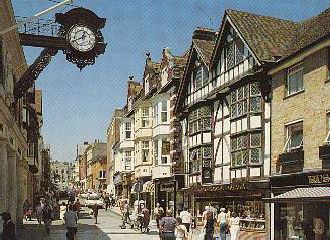 |
 |

Winchester
[Tuesday - 05/11/99] We left London this morning for Winchester to see the famous 'Round Table" hanging in the Great Hall there. Wee took the train from Waterloo and traveled just over an hour to find ourselves in the famous City of Winchester. The Romans used a pre-historic ford to cross the River Itchen, and founded a walled city called Venta Belgarum. Their main street, like Winchester's today, led from the Eastgate, down by the river, to the Westgate, and a small part of their rebuilt walls can still be seen beside the Weirs. Little remains of this Roman town because modern Winchester was built on top of it. It was King Alfred the Great, King of Wessex, who drove back the invading Danes and restored the city after the Dark Ages. Winchester was his capital and his statue dominates the Broadway. He is called the founder of the kingdom; he died and was buried in Winchester. His descendants became the first Kings of England.
One of the first Christian churches was built in Winchester by King Kenwahl in 648 AD and you can see its outline and that of St Ethelwold's 10th century Cathedral marked on the Winchester Cathedral Green. King Edgar was here when the remains of St. Swithun were moved inside the Cathedral on 15 July 971, and the celebrated rainstorm broke out that lasted for 40 days and nights and, later, King Canute placed his gold crown on the head of Christ at the altar where it stayed until the reformation. Since the 11th century the curfew has rung at 8:00pm. William the Conqueror came here to claim the English Crown and the Cathedral was rebuilt soon after the Norman Conquest. At 556 feet from east to west, it is the longest medieval, gothic cathedral in Europe, and one of the most beautiful. Here King Henry III was baptised, Henry IV was married, and Mary Tudor married Philip of Spain. William Rufus and the Anglo-Saxon Kings of England are buried in the choir.
Charles II did much to restore the city after the destruction of the Civil War. The 13th century Pilgrims' Hall is now used by the choristers. Winchester College was founded by Bishop William of Wykeham in 1382 for 70 poor scholars. 600 years on and boys are still educated there - using many of the original buildings.
The Bishop of Winchester lives in Wolvesey Palace, built at the time of Wren, beside the ruins of medieval Wolvesey Castle, which when built, was the largest domestic building in England. It was fortified by Bishop Henry of Blois during the battles between Stephen and Matilda which destroyed most of the city in 1141. After the royal residential quarters in Winchester Castle were burnt down in 1302, medieval and Tudor monarchs usually stayed at Wolvesey on their frequent visits to Winchester. It was at Wolvesey that Mary Tudor and Philip of Spain had their wedding feast and were accommodated after their marriage in the Cathedral in 1554.
Bishop Henry of Blois also founded the Hospital of St Cross. It is the oldest charitable institution still occupied in England. You can still get your Wayfarers' Dole from the gateman as a legacy from Bishop Henry.
Winchester is full of history. The Domesday Book was written here. Jane Austen died and was buried here. John Keats was inspired by the Water Meadows to write his "Ode to Autumn" and said the good air was worth 6d a pint. "It is the pleasantest town I was ever in," he said. We'd tend to agree.
|
Last modified on Wednesday, November 26, 2008 URL: http://www.housecorvus.org/win.htm Copyright © 1999, 2000-09 House Corvus. All rights reserved. Design and hosting by Bran Trefonnen. | |